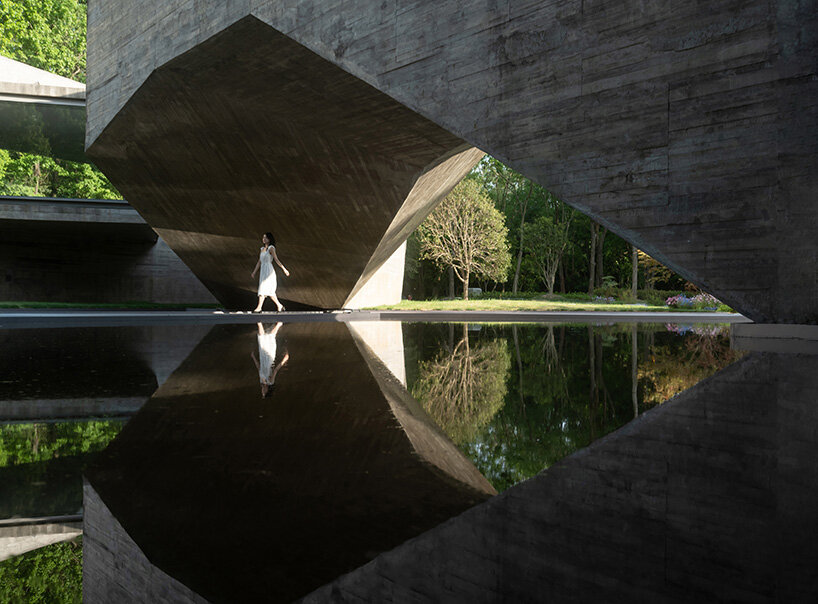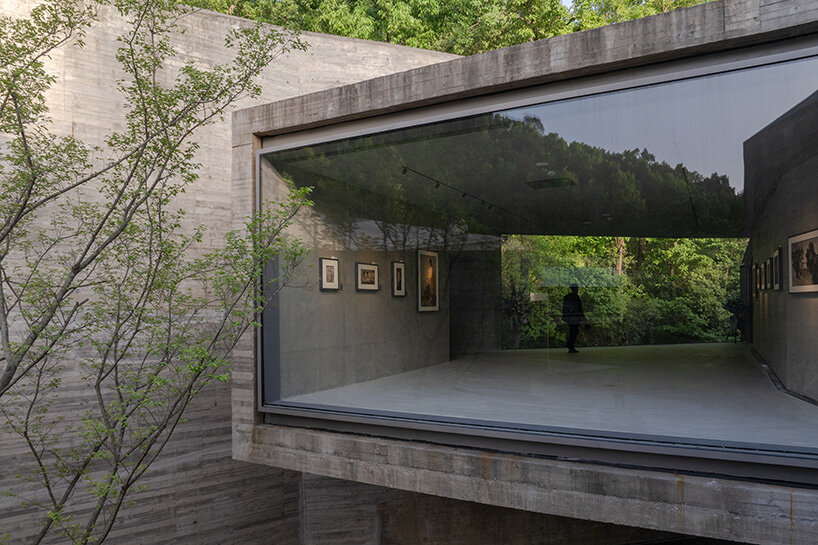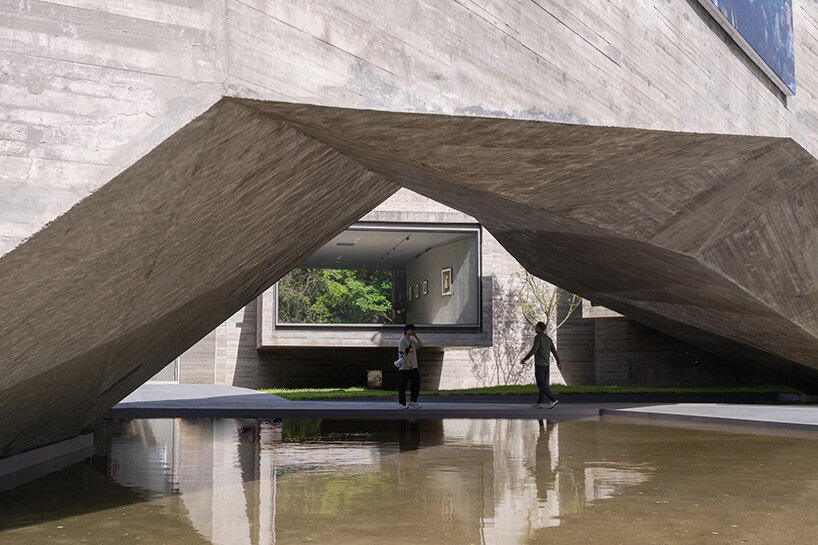Introduction to the Xiao Feng Art Museum
The Xiao Feng Art Museum by ZAO / standardarchitecture is located at the foot of Daci Mountain in Hangzhou’s Xihu District. The museum is situated in a dense forest that opens up to a concrete courtyard. It was conceived as a tribute to painters Xiao Feng and Song Ren, and it unfolds as a continuous architectural loop. The museum’s massing and voids are designed to trace the contours of the surrounding hills, creating an introverted structure that blends seamlessly into the landscape.
Approached from a forest road, the entrance to the museum is revealed gradually. Visitors walk beneath a cantilevered bridge that frames a still courtyard at the center of the composition. This inner garden defines the museum’s orientation, with its water surface mirroring the faceted underbelly of the concrete volumes above. The experience is buffered by the mountain’s canopy and the cool air rising from the shaded voids below the structure.
the museum sits quietly at the base of a mountain in Hangzhou | images © DONG image
Architecture and Design
Inside the museum, movement follows a circular route that is carefully curated by the architects at ZAO to mirror the museum’s organic plan. The galleries expand and contract as one progresses, forming a rhythm of compression and release. Narrow passageways lead to larger chambers, while sloped ramps connect the shifting floor levels. The transitions are smooth and deliberate, guiding visitors through a changing sequence of light, texture, and framed views of the landscape beyond.
The polygonal geometry of the building allows the galleries to project outward toward the courtyard. These extensions, sharp-edged volumes with large panoramic glazing, create visual exchanges between interior and exterior. From within, the forest becomes a suspended backdrop to the artworks. From the courtyard, the galleries appear as floating rooms in conversation with one another.

its form follows the contours of the hills, creating a continuous architectural loop
Materiality and Atmosphere
The entire structure is cast in concrete mixed with black ink pigment, giving the surface a muted, graphite-like tonality that deepens under varying light conditions. The texture, left exposed, bears the imprint of timber formwork, lending warmth to the otherwise monolithic material. The play between light and concrete defines the atmosphere: daylight entering through angular apertures shifts across the rough walls, while at dusk, interior illumination casts faint glows into the courtyard.
This material uniformity heightens the museum’s relationship with its setting. Against the lush green of the mountain, the dark concrete reads as a man-made strata within a geological landscape. The architecture of ZAO / standardarchitecture remains grounded in this contrast, where solid and void, enclosure and view, are held in careful balance.

the entrance is reached by walking beneath a cantilevered bridge into a still courtyard
Courtyard and Landscape
In the courtyard, the mirrored pools and exposed concrete planes evoke the character of a scholar’s garden reinterpreted through modern form. The reflections create a sense of depth that doubles the surrounding environment, while the sound of water softens the building’s angularity. Small trees grow within the interstitial spaces, their foliage brushing against the walls and glass, bringing a living counterpart to the mineral composition.

the galleries expand and contract as visitors move through the building

a reflecting pool mirrors the faceted concrete planes and frames the forest
Conclusion
The Xiao Feng Art Museum is a masterpiece of modern architecture that seamlessly integrates into its natural surroundings. The museum’s design, materiality, and atmosphere all work together to create a unique and immersive experience for visitors. The careful balance of solid and void, enclosure and view, creates a sense of harmony and balance that is rarely found in modern architecture. As a tribute to painters Xiao Feng and Song Ren, the museum is a fitting celebration of their work and legacy, and it will undoubtedly continue to inspire and delight visitors for years to come.

